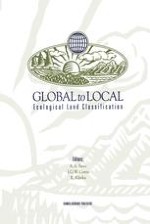1996 | OriginalPaper | Buchkapitel
A Community Classification System for Forest Evaluation: Development, Validation, and Extrapolation
verfasst von : Wayne K. Clatterbuck
Erschienen in: Global to Local: Ecological Land Classification
Verlag: Springer Netherlands
Enthalten in: Professional Book Archive
Aktivieren Sie unsere intelligente Suche, um passende Fachinhalte oder Patente zu finden.
Wählen Sie Textabschnitte aus um mit Künstlicher Intelligenz passenden Patente zu finden. powered by
Markieren Sie Textabschnitte, um KI-gestützt weitere passende Inhalte zu finden. powered by
A community classification system integrating vegetation and landforms was developed for the 8,054-ha Cheatham Wildlife Management Area (CWMA), located on the Western Highland Rim of Tennessee, USA, to obtain information on which to base multiresource land management decisions. A subjective procedure (synthesis tables) and several objective techniques (factor analysis, cluster analysis, and canonical discrimination) were used to evaluate importance values of overstory and midstory species, coverage values of understory species, and topographic parameters. These procedures were used collectively to guide and to provide evidence for interpretation of vegetational patterns on the landscape. The eight discrete communities identified on a 482-ha compartment within the CWMA were: northern red oak (Quercus rubra L.), chestnut oak (Q. prinus L.), scarlet oak (Q. coccinea Muenchh.), yellow-poplar (Liriodendron tulipifera L.), sycamore-sweetgum (Platanus occidentalis L. — Liquidambar styraciflua L.), black oak-hickory (Q. velutina Lam. — Carya spp.), post oak (Q. stellata Wangenh.), and American beech (Fagus grandifolia Ehrh.) communities. The classification system was validated with an independent data set. The eight communities were successfully extrapolated to an unsampled portion of the CWMA. Clearly, community analysis can become an important facet in forest management and may play a major role where a holistic understanding of vegetative relationships is essential.
